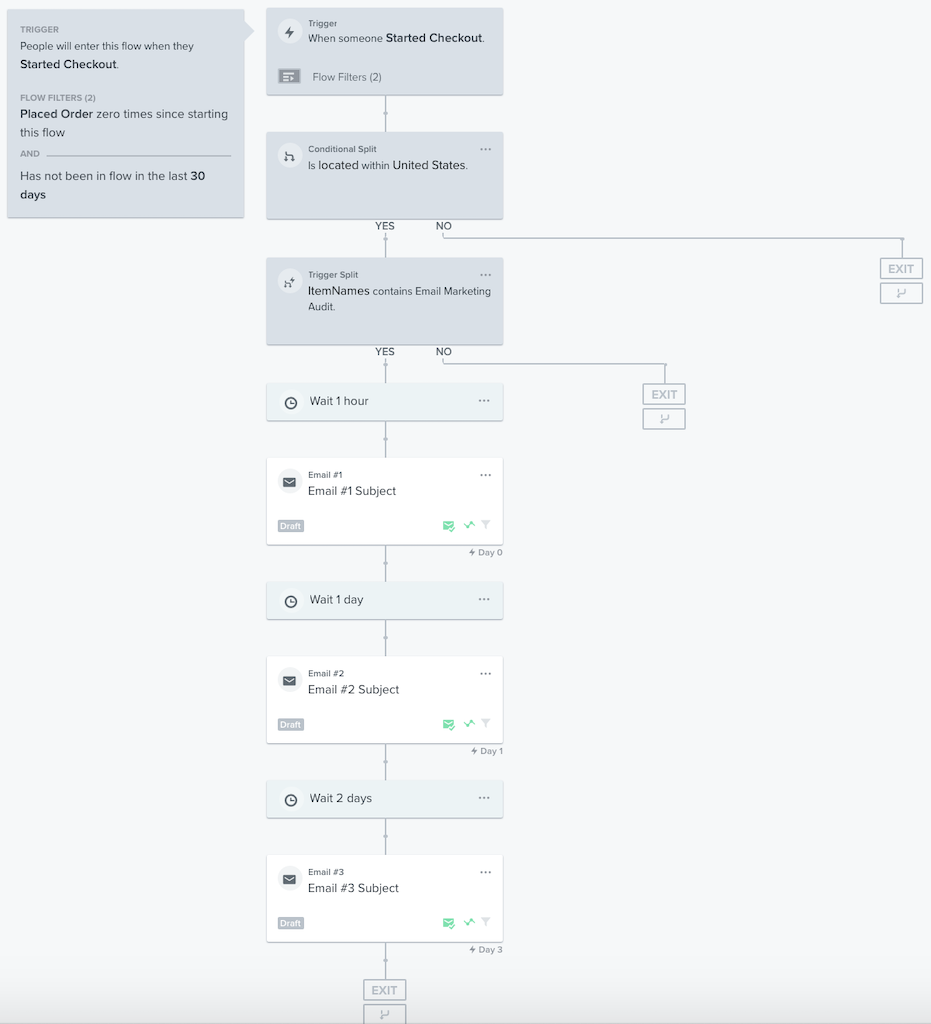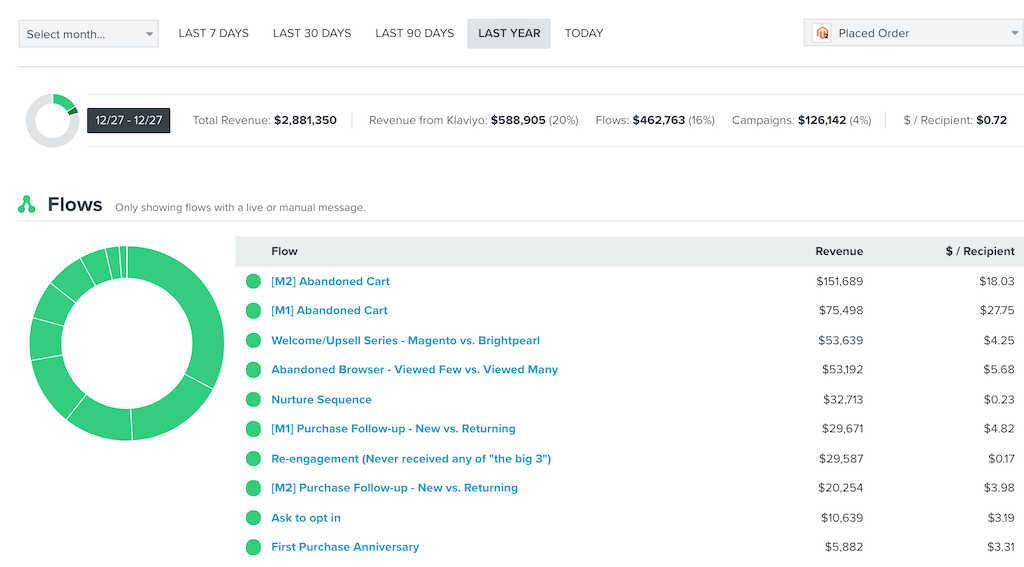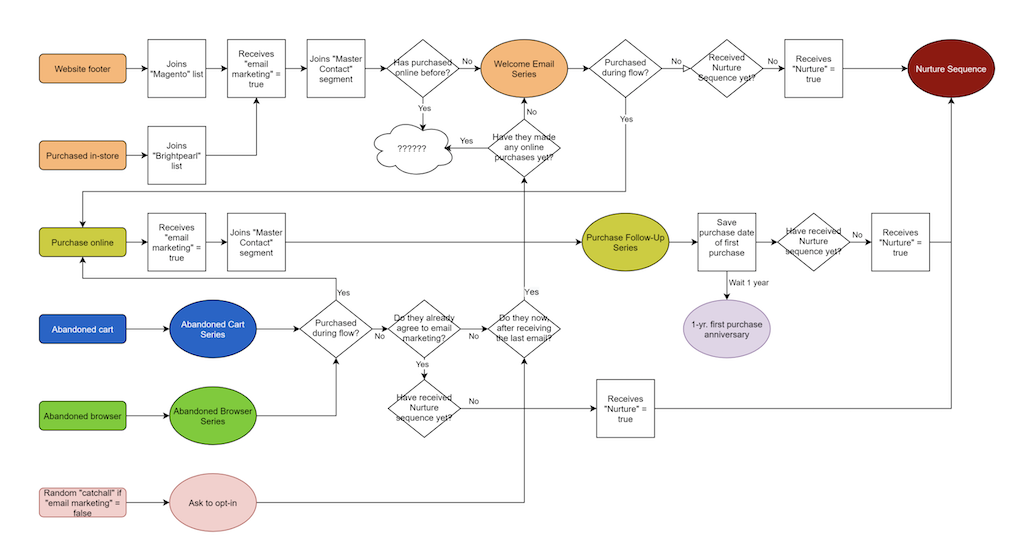The abandoned cart automation (also called a flow, customer journey, or sequence depending on your email marketing provider) is among the three essential automations any brand needs to implement if you’re selling things online. Recently, someone asked me how long it takes to build one of my abandoned cart flows, but the real question is, how do I optimize my abandoned cart flow for conversion?
It starts with hyper-targeting segmentation, and Klaviyo makes this incredibly easy.
What is Hyper-Targeting Segmentation?
There are several ways you can segment customers. In fact, HubSpot lists seven customer segmentation models, and hyper-targeting falls under the behavioral customer segmentation model.
Hyper-targeting or hyper-focused segmentation means talking to different segments of people based on their cart size, items in their cart, previous engagement with your emails, location, and previous shopping behavior with you.
People can be abandoning a $5-item or they can be abandoning a $5,000-item. They can be a return customer or they can be a first-time customer that’s just shown up to your store today. And so on…
Each one of those personas have a different psychology at the time of abandonment so you need to speak to them differently in your copy—that’s exactly how you make it hyper-focused and hyper personalized.
Another factor to consider in your Klaviyo abandoned cart flow is the person’s location. Are they domestic or international customers? This is important because you probably have much different shipping policies, return policies, and currency issues. How you speak to an international customer is going to be different than the way you speak to a domestic customer. And again, how you speak to your customers in setting up these things is what makes it personal.
The goal here is to make potential customers see that you’re paying attention to them, that you understand what they’re going through, and that you’re just there to help them through that situation. Ultimately, this helps you recover that cart.
There are a few other tricks we can use by using dynamic content in the emails themselves, but that’s another topic. For now, let’s just look at the setup.
Creating Klaviyo Abandoned Cart Flow
If you’re a Klaviyo user, I assume you know how to create a new flow from scratch or update your existing abandoned cart flow. From there, these are the steps:
1. Add the Started Checkout Trigger and Flow Filters
Before an email gets sent to your client, Klaviyo checks the flow filters you’ve added to the trigger. It doesn’t matter if you have 3 emails or 55 emails in the flow. If somebody has received any of the emails and they convert before “the next” email gets sent out, they will fail the filter conditions and automatically get kicked out of the entire flow. (Bonus points if you have another automated flow they get kicked to after converting.)
As an example, I added two trigger filters to start:
- Placed orders zero time since starting this flow, and
- Has not been in the flow for 30 days.
The first filter is the one that will kick people out if they convert during the flow, and the second filter is for big fans of your website who are quite wishy-washy.
These people come to your website every day or every week, put something in their cart, and then abandon it. You don’t want to send that person this flow every time this happens so this filter is going to limit them going through this flow to just once per month.
Segmenting Klaviyo Abandoned Cart Flow
Now we can continue segmenting people in our flow based on their behaviors and other properties. I list my hyper-segments below, along with examples on how it’s done when creating your Klaviyo abandoned cart flow.
2. Domestic versus International Customers
We talked about segmenting domestic versus international customers. This is done in Klaviyo abandoned cart flow by adding a conditional split based on the user’s location. I normally use the conditional split “Someone is or is not within the EU” and specify the location. As an example, I indicated the United States as the location, so if your contact is located in the U.S., they will follow down this yes path. If they are outside of the US, it’s going to go down the no path.
3. Specific Items in the Cart
This is helpful any time you really want to focus on selling specific item(s).
For example, let’s say you’re a fashion retail boutique having a year-end blowout sale because you’re getting a shipment of the new styles for the upcoming year. It would make sense to focus and target the people who have last year’s items in their carts so that you can get rid of them faster.
For that, you would need to add a trigger split, select “CheckoutProducts” (or “ItemNames,” depending on your e-commerce integration), and specify the item(s), noting that the product that you’re trying to blow out in the U.S. may be different than the product you’re blowing out internationally.
Whatever integration you have with your store, it’s going to list your actual products, so you just have to choose the one that you’re trying to blow out
If your only goal is to make sure you sell this product, then you don’t have to do any further segmentation down the “yes” path because you don’t care if it’s their first or third purchase. You don’t care if their cart value is only this product or if it’s $20,000. The only thing you care about is selling this product.
Let’s assume that and add a one-hour time delay before Klaviyo sends the first email.
It’s up to you to test and decide how many emails you want to send, but I normally start with three and adapt from there. You can also test and choose how long to wait between each email. Again, I start with 1 day and 2 days as shown below.
4. Cart Size
Now we have the path for customers with a specific product in their carts, but what about the customers whose cart doesn’t contain the product you’re trying to target? We can add another trigger split, but this time on the “no” path of the previous step.
For this trigger split, I normally go by cart size (cart value). Choosing this value is dependent on your products, your average price point, your average order values, and your average sales. It’s something specific to you, and it’s important because somebody’s mindset of losing a $10 item is different than somebody that’s about to lose a $7,000 item.
I’ve added $1,000 here as an example. This means that if the cart value is greater than $1,000, they’re going down the “Yes” path. If the cart value is less than $1,000, they’re going down the “No” path.
5. Returning versus First Time Customers
After segmenting potential customers by cart size, what do we want to think about next? Well, next I would think about, “are they a returning customer or a brand new customer?”
This is another conditional split based on “what someone has or has not done,” and “placed order at least once over all time.”
If they have placed an order at least once over all time, that means they are a returning customer and go down the “yes” path.
The way to think about this is that somebody coming back to you for a second, third or fourth time is different than somebody that has never purchased with you before. The return customer already knows who you are and is already educated about your brand. The new customer may or may not, and both of those conditions need to be reflected in your email copy.
And now you’re ready to add time delays and emails as you’ve done before.
Hyper-Segmented Klaviyo Abandoned Cart Flow
Once you’ve added your final emails above, you should have your completed hyper-segmented abandoned cart flow with 14 to 18 emails. The next step is writing all these emails, and you’ll want to follow these tips to avoid the spam folder.
Further Improving the Abandoned Cart Flow
Even with hyper-segmentation, is it possible to make this flow even better? Yes.
As I mentioned before, you can use dynamic content to display certain content to certain people based on properties and information saved about them in your Klaviyo account.
Second, Klaviyo also offers a fully-integrated SMS service with their platform. You can ask people if they prefer to receive emails or SMS. If they do engage with SMS, you’ll need separate branches for email vs. SMS. That would be true for all of the filters or segments we created.
No matter what they prefer or how they engage, Klaviyo keeps track of all of it. You can use that information to trigger new flows or display different content. Again, hyper-focusing on people based on THEIR behaviors and preferences.
Wrapping it up
We’ve had amazing success with this hyper-segmented abandoned cart flow. In fact, it has recovered over $227,000 in a single year for just one client. (It’s actually over $275k in 14 months, but I can’t get that into a pretty picture as direct proof.)
If you’re able to get into the mindset of your buyer, understand what it means to abandon a $5,000 cart versus a $25 cart, and your email copy reflects all that, then you’ll have these same results too.
And if this is all still a bit over your head or you just don’t have time to do it yourself, get in touch with us today. We’ll have this all set up and firing on all cylinders in about 2 weeks.
Klaviyo Abandoned Cart Flow Bonus Tips!
Bonus tip #1! You’ll notice that there is now a 4th email at the end of every branch. That last email is to ask people to opt into your email marketing.
Under GDPR, you’re allowed to send abandoned cart emails to people that are not explicitly opted into your list. It’s legal, it’s ethical, it’s fine. My understanding is that it’s covered under the “legitimate interest” clause. However, I’m not a lawyer and this isn’t legal advice. Please check with an actual lawyer licensed in your state and country.
Which is to say, if they are not explicitly opted in, you cannot email them your regular newsletters and campaign emails after they’ve finished this flow. You can simply ask them if you can keep emailing them by visiting an opt-in page and filling it out. Or if you know your way around Klaviyo, just clicking a link to update a property.
If you can’t recover their cart, you should at least try to recover them. Then get them to convert later on in a different flow.
Bonus tip #2! If you’re just starting your email marketing account, you’ll also want to implement SPF, DKIM, and DMARC policies as well as “warm-up your domain.” That is, only send emails to your highest engaged segments for 2 weeks that are likely to get 50% – 60% open rates and >10% click rates. Abandoned Cart and Welcome emails fit that description really well.
Bonus tip #3! Want to generate over $526,000 in 14 months using Klaviyo automated flows as shown above? Map your entire customer journey and create a system of automated flows based on user behavior.













0 Comments